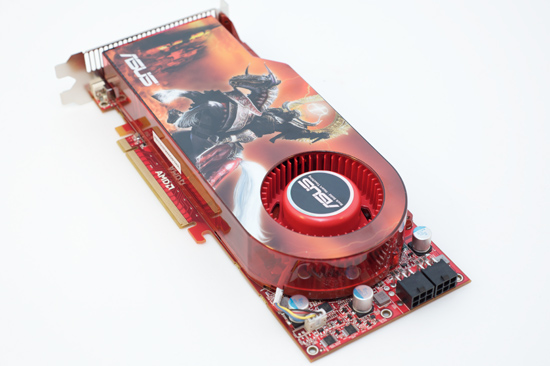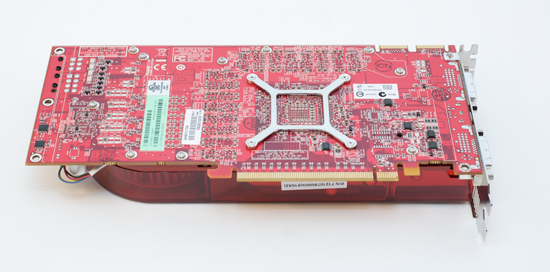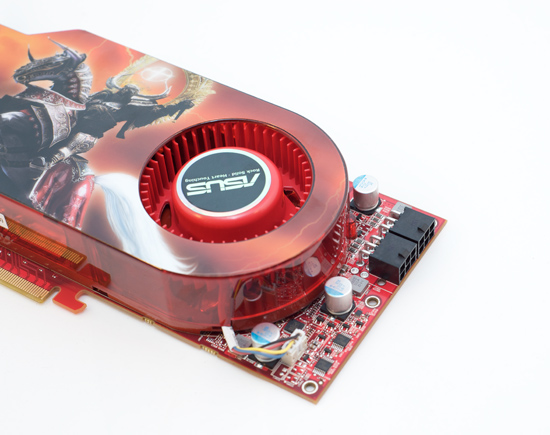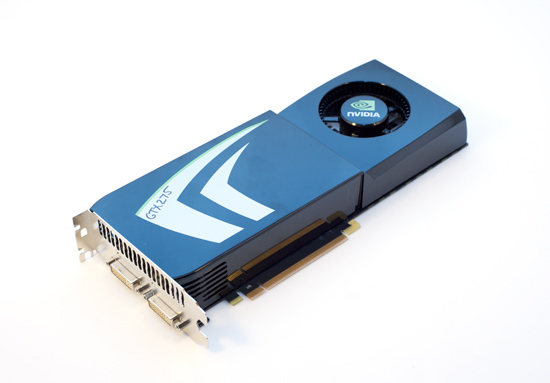ATI Radeon HD 4890 vs. NVIDIA GeForce GTX 275
by Anand Lal Shimpi & Derek Wilson on April 2, 2009 12:00 AM EST- Posted in
- GPUs
The Cards and The Test
In the AMD department, we received two cards. One was an overclocked part from HIS and the other was a stock clocked part from ASUS. Guess which one AMD sent us for the review. No, it's no problem, we're used to it. This is what happens when we get cards from NVIDIA all the time. They argue and argue for the inclusion of overclocked numbers in GPU reviews when it's their GPU we're looking at. Of course when the tables are turned so are the opinions. We sincerely appreciate ASUS sending us this card and we used it for our tests in this article. The original intent of trying to get a hold of two cards was to run CrossFire numbers, but we only have one GTX 275 and we would prefer to wait until we can compare the two to get into that angle.



The ASUS card also includes a utility called Voltage Tweaker that allows gamers to increase some voltages on their hardware to help improve overclocking. We didn't have the chance to play with the feature ourselves, but more control is always a nice feature to have.

For the Radeon HD 4890 our hardware specs are pretty simple. Take a 4870 1GB and overclock it. Crank the core up 100 MHz to 850 MHz and the memory clock up 75 MHz to 975 MHz. That's the Radeon HD 4890 in a nutshell. However, to reach these clock levels, AMD revised the core by adding decoupling capacitors, new timing algorithms, and altered the ASIC power distribution for enhanced operation. These slight changes increased the transistor count from 956M to 959M. Otherwise, the core features/specifications (texture units, ROPs, z/stencil) remain the same as the HD4850/HD4870 series.
Most vendors will also be selling overclocked variants that run the core at 900 MHz. AMD would like to treat these overclocked parts like they are a separate entity altogether. But we will continue to treat these parts as enhancements of the stock version whether they come from NVIDIA or AMD. In our eyes, the difference between, say, an XFX GTX 275 and an XFX GTX 275 XXX is XFX's call; the latter is their part enhancing the stock version. We aren't going to look at the XFX 4890 and the XFX 4890 XXX any differently. In doing reviews of vendor's cards, we'll consider overclocked performance closely, but for a GPU launch, we will be focusing on the baseline version of the card.
On the NVIDIA side, we received a reference version of the GTX 275. It looks similar to the design of the other GT200 based hardware.

Under the hood here is the same setup as half of a GTX 295 but with higher clock speeds. That means that the GTX 275 has the memory amount and bandwidth of the GTX 260 (448-bit wide bus), but the shader count of the GTX 280 (240 SPs). On top of that, the GTX 275 posts clock speeds closer to the GTX 285 than the GTX 280. Core clock is up 31 MHz from a GTX 280 to 633 MHz, shader clock is up 108 MHz to 1404 MHz, and memory clock is also up 108 MHz to 2322. Which means that in shader limited cases we should see performance closer to the GTX 285 and in bandwicth limited cases we'll still be faster than the GTX 216 because of the clock speed boost across the board.
Rather than just an overclock of a pre-existing card, this is a blending of two configurations combined with an overclock from the two configurations from which it was born. And sure, it's also half a GTX 295, and that is convenient for NVIDIA. It's not just that it's different, it's that this setup should have a lot to offer especially in games that aren't bandwidth limited.
That wraps it up for the cards we're focusing on today. Here's our test system, which is the same as for our GTS 250 article except for the addition of a couple drivers.
The Test
| Test Setup | |
| CPU | Intel Core i7-965 3.2GHz |
| Motherboard | ASUS Rampage II Extreme X58 |
| Video Cards | ATI Radeon HD 4890 ATI Radeon HD 4870 1GB ATI Radeon HD 4870 512MB ATI Radeon HD 4850 NVIDIA GeForce GTX 285 NVIDIA GeForce GTX 280 NVIDIA GeForce GTX 275 NVIDIA GeForce GTX 260 core 216 |
| Video Drivers | Catalyst 8.12 hotfix, 9.4 Beta for HD 4890 ForceWare 185.65 |
| Hard Drive | Intel X25-M 80GB SSD |
| RAM | 6 x 1GB DDR3-1066 7-7-7-20 |
| Operating System | Windows Vista Ultimate 64-bit SP1 |
| PSU | PC Power & Cooling Turbo Cool 1200W |










294 Comments
View All Comments
Warren21 - Thursday, April 2, 2009 - link
Yeah, I don't know why they're playing this off as an RV770 overclock. RV790 is indeed a respin of RV770, but hey if nV can get by with 1000 different variants on the same GT200... Why not mention the benefits/differences between the RV770 and the RV790? Disappointed.SiliconDoc - Monday, April 6, 2009 - link
I guess they didn't mention the differences ? Tell you what, when ati gets 999 more rebrands and catches up with their competitotr, we'll call it even, ok ?In the mean time, the 4870 crossfires with the 4980, and soon enough we'll have the gamer joe reviewers that downclock the 4890 and find it has identical results to the same clocked 4870 - at that point the red roosters will tuck their flapping feathers and go home.
I know, it's hard to see it coming, when all you can see is s tiny dot of red, in a sea of 1000 choices of green. rofl
bill3 - Thursday, April 2, 2009 - link
According to info at other sites, the 4890 has 3 million more transistors (959 instead of 956, very little difference). It also has a somewhat larger die due to tweaks made to allow the higher clocks.Go to Firing Squad or Xbitlabs review, both have an certain ATI slide that explains the small changes in detail.
SiliconDoc - Monday, April 6, 2009 - link
" Because they’re so similar, the Radeon 4870 and 4890 can be combined together for mix-and-match CrossFire, just like the 4850 and 4870. "I guess it's not a rebrand.
roflmao
bill3 - Thursday, April 2, 2009 - link
http://www.firingsquad.com/hardware/ati_radeon_489...">http://www.firingsquad.com/hardware/ati..._4890_nv...The slide is the first clickable pic on that page, actually. Didn't realize we could do links.
bill3 - Thursday, April 2, 2009 - link
Or even betterhttp://www.firingsquad.com/hardware/ati_radeon_489...">http://www.firingsquad.com/hardware/ati...0_nvidia...
heh
Proteusza - Thursday, April 2, 2009 - link
Thanks guys, good read.The piece on PhysX kinda mirrors my thoughts on it - its not worth basing a GPU purchasing a decision on it because it affects so few games. If you design your game around PhysX, you end up making a gimmicky game, if you design a good game and think of good ways to let PhysX enhance it, you can make something good like Mirror's Edge.
The way I think about PhysX is based on Amdahl's law, which says that overrall speedup of a CPU from an enhancement that affects only a certain class of application is affected by the amount of time spent using that certain class of application. In the case of PhysX, the amount of time spent using it is generally extremely low, and when it is used the effect isnt always noticeable or worth having.
NVidia's marketing tactics leave a lot to be desired frankly, although I'm not naive enough to say AMD never tries a little marketing manipulation themselves.
Sylvanas - Thursday, April 2, 2009 - link
Why on earth would you compare a newly released Nvidia driver to that of an ATI driver from December last year and a Hotfix at that? The latest ATI drivers have had substantial improvements in a few games and surely they would have sent you an up to date driver with the 4890 review sample- somethings not right there. Also, where was the overclocking comparisons? (some reviews stating 1ghz core 4890 no problem). What about Temps and Stock cooling fan noise?7Enigma - Thursday, April 2, 2009 - link
I'm a bit disappointed with the ATI card. That is pretty much the Sapphire Vapochill model with increased core (actually it's a slightly slower memory setting). At least the GTX 275 is something different.bill3 - Thursday, April 2, 2009 - link
Wow lol..both cards are just rehashes. Calling the Nvidia card "something different" is a hell of a stretch.. it's just their same other cards with various clocks twiddled for the trillionth time.If anything the ATI card brings more to the table, as it offers much more clock headroom (1ghz is said to be well within reach) due to it's redesign, while the Nvidia card is nothing at all new intrinsically (aka it will overclock similar to the 285). Too be fair Nvidia's better clock-capable models (285) just came out a couple months earlier instead of now.